
Businesses today operate in a customer-centric environment, and they constantly seek ways to connect more efficiently with customers and prospects. Dialing systems such as predictive dialers have emerged as game-changing tools, revolutionizing outbound communication through automation. But what exactly is a predictive dialer, and how does it work, and more importantly, is it useful for your business?
If you run a call center or a telesales team, one thing is obvious, and that is – you want maximum output with your resources and also want to reduce idle time. Predictive dialers can increase the efficiency of your call center agent by 25-30%, no matter whether you’re a small or medium-sized business.
We’ll break down more about predictive dialers in this blog, and walk you through some real-world use cases and best practices as well.
Before a deep dive into this fascinating topic, let’s have a glance at what we are going cover in it—
What is a Predictive Dialer?
Powered by AI, a predictive dialer is a specialized system that dials a list of telephone numbers based on the predictive availability of an agent and connects the answered calls to him. Yes, you read that right, a predictive dialer does not wait until an agent is available; rather, it starts dialing numbers before his current call is done and thus decreases idle time between calls.
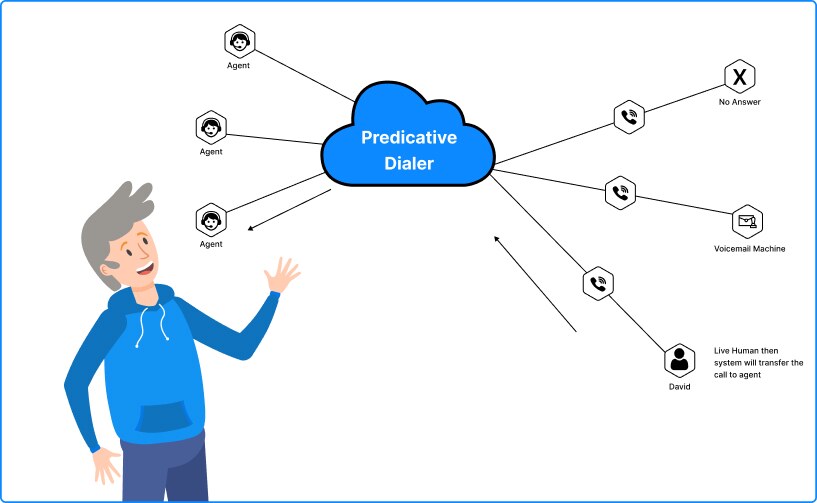
A predictive dialer system is a blessing for you and your agents cause it can increase outbound calling efficiency by 33% over dialing one number at a time. Whereas traditional systems utilize the agents and keep them occupied for 40 minutes per hour, a predictive dialer can increase it up to 57 minutes. Source
Let me explain it further. Predictive dialers use statistical data and algorithms to minimize the time agents wait between calls. It also minimizes occurrences like someone answering the call when no agent is available. By analyzing how frequently the dials are answered, predictive dialers dial several lines at a time. An agent can switch right from one call to another without spending idle time.
Importance of Predictive Dialer in Call Centers
In a call center where every moment counts, idle time is the primary efficiency killer. Studies show that call centers lose up to 33% of their efficiency due to idle time. So, what exactly is idle time and why does it have such a substantial impact on productivity?
Understanding Idle Time and Predictive Dialer:
Idle time in call centers refers to the period when an agent is not actively engaged in a call. This downtime can arise from various reasons. But there are two main sources of delay in manual or auto dialing where one number is dialed at a time.
One, dials that are not answered. Suppose, with a list of leads, 1 out of 4 dials are answered. You don’t need to waste time dialing the unanswered numbers one by one. In this case, a predictive dialer will analyze the calls, dial 4 lines each time, and connect the answered call to an agent when available.
Another thing is— even if the dial is answered, you are supposed to wait for the ring time. Interestingly, a predictive dialer can eliminate that by dialing numbers before you finish your current call. It analyzes the average call durations and predicts when an agent will be available.
Evolution of Predictive Dialers
Predictive dialer systems have come a long way – from hardware-based on-premise systems, they have evolved into Software as a Service (SaaS) solutions hosted on the public cloud using AI and real-time analytics to optimize efficiency across teams.
- Early dialers in the 1990s used simple logic to call through lists, however, they lacked real-time adjustments that often led to those awkward silences when a customer picked up and no agent was ready.
- Then, in the 2000s, things got interesting as predictive algorithms became smarter and more dynamic. These algorithms made predictions based on average call handling time, availability of the agents, and the number of calls being dialed. This significantly reduced agent idle time.
- Modern predictive dialers have advanced capabilities, including integrating with CRMs, comprehensive reports and analytics, and adjustable dialing pace. It’s no more just dialing phone numbers, rather optimizing the whole outbound communication process of a business.
- The predictive dialer software market is divided into two main components: software and services. In 2024, the software segment held a significant market share of 66.7%, driven by the increasing demand for automated calling solutions in contact centers.
Today, there are several types of dialers that are available for use. Let’s explore how predictive dialers are different from other types of dialers next.
How Predictive Dialers are Different From Auto, Power, & Progressive Dialers?
Often, predictive dialers are easily confused with other forms of dialers, particularly autodialers. However, each dialer has a different level of intelligence and functioning.
| Feature | Predictive Dialer | Auto Dialer | Power Dialer | Progressive Dialer |
| Dialing Speed | Dials multiple numbers simultaneously based on predictions. | Dials numbers automatically from a list. | Dials one number at a time, initiated by the agent. | Dials one number at a time automatically. |
| Agent Availability | Aims to connect live calls the instant an agent is free. | Connects answered calls to the next available agent, regardless of immediate readiness. | Agent initiates each dial after becoming available. | Connects only live answered calls to available agents. |
| Abandonment | Higher potential for “dead air” if predictions are inaccurate, leading to abandoned calls. | Higher potential for “dead air” and abandoned calls if no agent is immediately available. | Minimal to no “dead air” as agents initiate dialing. | No “dead air” as it only connects live answers. |
| Agent Control | Less direct control over the timing of each dial. | Less direct control over the timing of each dial. | High level of control; agent initiates each call. | Moderate control; agent is connected only to live answers. |
| Intelligence | Uses algorithms to predict agent availability and optimize dialing rate. | Simple sequential or round-robin dialing. | No prediction involved; purely agent-driven. | Basic logic to connect only live answers. |
| Efficiency | Highest potential for maximizing agent talk time and overall call volume. | Can increase call attempts but may not maximize agent talk time due to dead air. | Can improve efficiency compared to manual dialing but is paced by the agent. | Improves efficiency over manual dialing by automating non-live connections. |
| Compliance Considerations | Requires careful monitoring and optimization of dialing ratios to minimize abandonment rates and comply with regulations. | Higher risk of compliance issues due to potential for high abandonment rates. | Generally lower compliance risk due to agent control. | Moderate compliance risk; need to ensure proper handling of no-answers etc. |
How Does a Predictive Dialer Work?
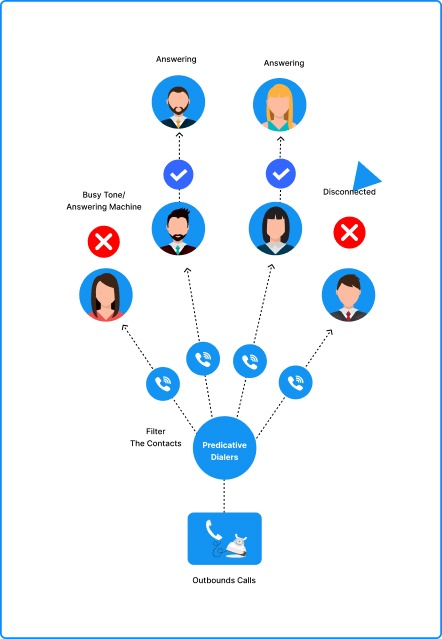
At its core, a predictive dialer performs the following steps:
1. Data is Fed into the Dialer System
The very first step involves data input, i.e., the list of phone numbers of customers and prospects that need to be called, along with the information about available agents.
2. The Algorithm Performs Analysis
The dialer algorithm analyzes various factors, including the
- Availability of the agents
- Estimates average call length
- Average pickup rates
- Abandonment Rates
3. Performs Dialing Process
Based on predictions, the dialer dials multiple numbers. It dynamically adjusts the number of calls being dialed simultaneously. This means that if more agents are free and the answer rate is high, it might dial more numbers.
4. Connects Live Calls to Agents
At this stage, the dialer routes the live calls to available agents. It is important to note that the dialer aims to connect the call to an agent the instant the person on the other end picks up and says “hello.”
5. Data Feedback
The dialer system generates and feeds the outcome of each call back into the algorithm. This helps the algorithm to learn and refine its predictions for future dialing.
Benefits of a Predictive Dialer
Predictive dialers have become increasingly prevalent in recent years, the reason behind is the integration of Artificial Intelligence and Machine Learning. This trend is expected to continue its upward trajectory as we found the evidence of this rapid expansion in one of Grand View Research’s study, which states:
The global market for predictive dialer software is projected to skyrocket from USD 1.03 billion in 2020 to a staggering USD 12.2 billion by 2028.
So, why should you use a predictive dialer system over any other dialing software? There are some unique features and benefits of this automated, artificial intelligence (AI) powered software that’s going to satisfy you right away.
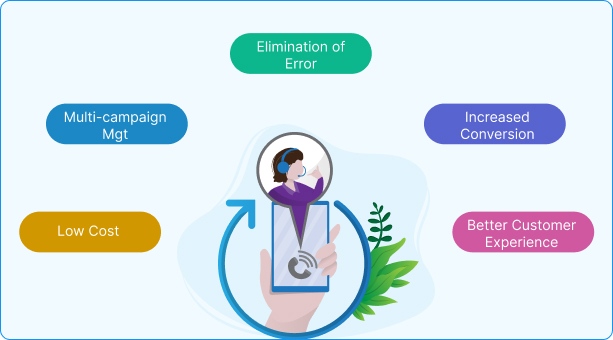
Increased Productivity
As we showed you before, predictive dialer software increases productivity minimum by 20-25%. It’s like turning your call center agents or sales reps into productive superheroes, making them three times more effective than the old-school methods.
However, this rate sometimes depends on your outbound call volume, the size of the support team, the type of business, and setting up data for outbound calls.
Cost Efficiencies
It’s a cost-saving wizard as well. Instead of wasting time dialing a number and hoping for someone to pick it up, a predictive dialer focuses on maximizing productivity and minimizing idle time. And that’s the only way to cut costs in a call center, isn’t it?
Multi-Campaign Management
Predictive dialers aren’t just efficient; they are smart too. Imagine you are about to run two campaigns at the same time— no worries, the dialer ensures they won’t get bombarded with calls. Smart pacing keeps the outreach smooth, avoiding any campaign chaos.
It’s like having an intelligent coordinator for your campaigns, making sure your customers aren’t overwhelmed.
Elimination of Human Error
Human touch is always great, but they slip up sometimes. Predictive dialers? Not that much. Precision is their game, and they never miss a beat. So, no more dialing mishaps or downtime. It’s a time-saving superpower, ensuring every call lands where it’s supposed to, accurately and efficiently.
Increased Conversions
Predictive dialers are on a mission to cut the wait time, so agents spend more time talking to customers. That means more interaction with the audience and more conversions. Studies and reports indicate that using predictive dialers can significantly boost conversion rates, potentially increasing them by as much as 30%.
Enhanced Customer Experience
Predictive dialers use data to understand the customers, and they know when to call them, respecting your customers’ preferences and time zones. No more annoying calls at inconvenient times or to people on the do-not-call list.
Practical Use Cases for Predictive Dialer System
Often, predictive dialers are considered useful for customer support teams; however, in reality, they have practical applications across many other industries. Let’s take a look:

Sales Teams
Sales representatives are bound to connect with customers over phone calls. Predictive dialer solution helps them by dialing more phone numbers, which increases their chances of closing deals and not wasting their time on voicemails and disconnected numbers.
Subscription Renewal and Upselling
Predictive dialing systems streamlines customer engagements for subscription-based businesses. It optimizes agent efficiency for successful renewals and upselling.
Political Campaigns
Political campaigns rely on mass outreach, and predictive dialers can be the ideal solution to reach hundreds and thousands of voters and volunteers.
Customer Feedback and Surveys
Outreach calling campaigns post post-purchasing, and service feedback are important for businesses. A predictive dialer can be a useful tool by automating the calling process and allowing agents to quickly connect and ask for feedback from customers.
Telehealth Providers
Another area where dialers can do magic is telehealth. Predictive dialers can be used to remind patients about upcoming virtual consultations, follow-ups, etc., which helps reduce no-shows.
Debt Collection Agencies
Recovery agencies often need to reach out multiple times across many accounts. By automating the dialing process and taking care of the follow-up calls, predictive dialers can maximize recovery.
Fundraising Campaigns for Non-Profits
Non-profit organizations leverage predictive dialing systems in fundraising campaigns to dynamically connect calls with available agents. This not only ensures a seamless flow of donor interactions but also maximizes donor engagement, ultimately leading to increased contributions.
Why is Cloud-Based Predictive Dialer the Best Choice?
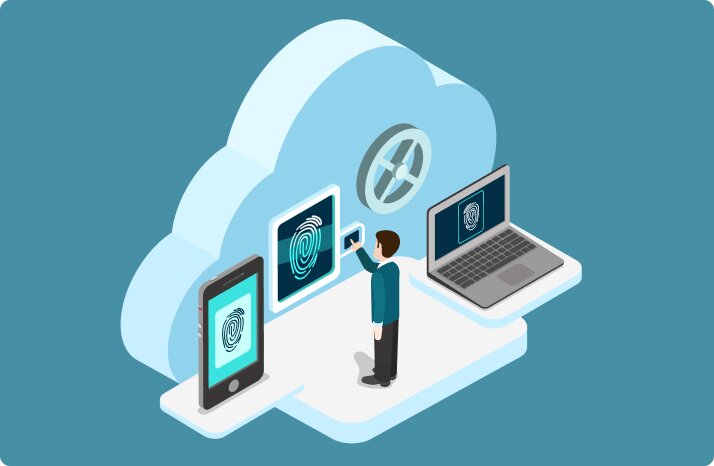
The predictive dialer system has been revolutionized over time. At first, there were hardware-based predictive dialing systems, but now you don’t need to install an expensive machine for it anymore. You can use a cloud-based system that is easy to use, cost-effective, and has no extra hassle on your own.
What is a Cloud-based Predictive Dialer?
This is a technological marvel that has evolved from traditional hardware solutions to become the go-to choice for modern contact centers. Unlike its hardware counterparts, cloud predictive dialer operates through the cloud, offering a host of benefits. It efficiently handles call routing, recording, transfer, monitoring, and distribution.
Why Should You Consider a Cloud-based System?
The appeal of a cloud-based predictive dialer lies in the compelling advantages it brings to the table. Agents can spend more time engaging with clients, thanks to features like voice broadcast and answering machine detection.
What sets a cloud-based system apart are benefits and features like—
- Cost-effectiveness – Drastically reduces upfront capital expenses and IT costs, making it a budget-friendly choice
- Voice broadcast – for simultaneous messaging
- Answering machine detection – helps identify answering machines and leaves messages
- Time zone awareness – to optimize call timings for a better customer experience
- Local presence of caller ID – facilitates improving answer rates and better engagement
- Seamless CRM integration – ensures efficient lead generation
Best Practices for Setting Up Predictive Dialer
Implementing a predictive dialer system in your business involves a strategic approach to optimize outbound calls effectively.
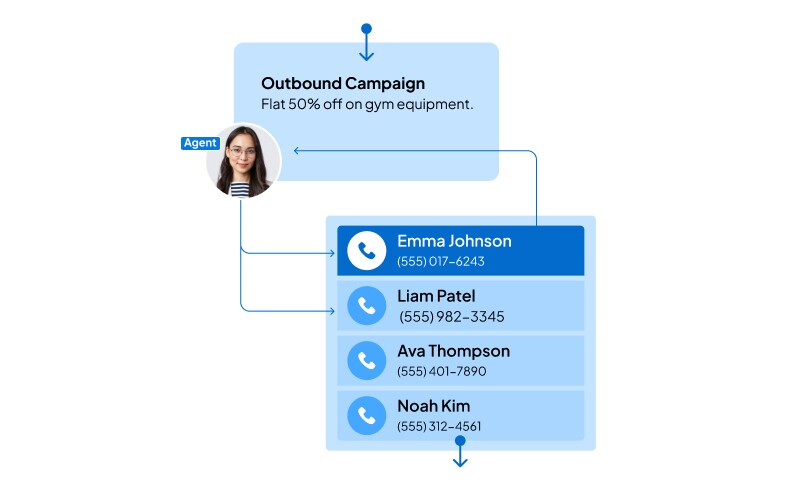
Understand Your Call Patterns
Before you even start, take a moment to understand how your calls usually go. Find out stats regarding the number of calls per day, average call duration, and the pickup rate insights that help determine the optimal number of support agents required to achieve your business goal.
Leverage Call Scripts & Train Agents
One key strategy is the use of customized scripts. Having access to call scripts helps agents know what to say the moment someone picks up, especially when taking calls one after the other.
While sales scripts provide a foundation, an exclusive reliance on them can risk sounding robotic. It is important for agents to stay natural as well. Train your sales and support team to leverage data from the CRM system and personalize scripts for outbound calls.
Monitor Your Call Drop Rates
In the U.S., FCC regulations require that call abandonment rates must not exceed 3% of live calls.
Suppose your dialer calls too many contacts at once, however, no agent is available when someone picks up. Result? The call gets dropped. Such situations lead to frustrated customers and even complaints. Therefore, make sure your drop rates do not go above 3% – and if you see red flags, make sure to tune your dialer settings.
Consider Integration with CRM
Your predictive dialer can work wonders if connected to your CRM. Why? This is because call data, notes, and lead status sync automatically between systems ensuring that sales and support teams are on the same page.
Stay Compliant
Dialers are powerful, but you need to ensure that your system doesn’t overstep. Therefore, you need to stay compliant with standard regulations such as TCPA, DNC, and other laws as per your operational area. Remember that ensuring compliance helps your business run smoothly and keeps your reputation intact.
How to Choose the Right Predictive Dialer for Your Business?
Alright, now if you decide to purchase predictive dialing software, it’s not a one-size-fits-all kind of deal. The best dialer for you depends on how your company operates, its culture and what your campaign is all about.
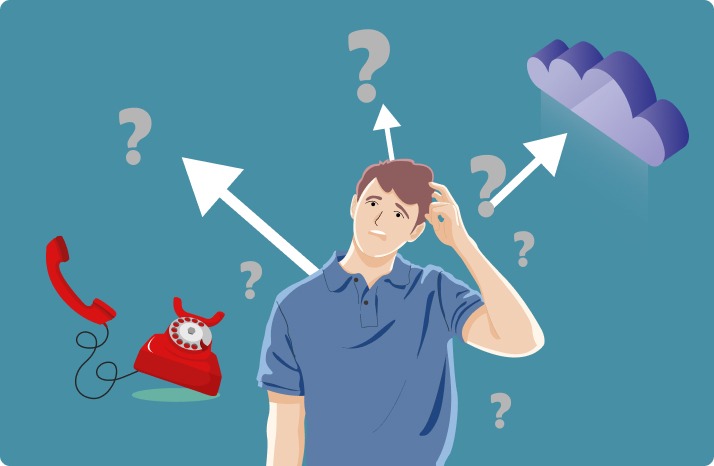
Standard Operating Groove
Consider what your aim is for each interaction. The more tasks your agents juggle between calls, the slower the dialing cadence needs to be. It’s all about finding that rhythm.
Team Size
How big is your squad? A smaller team means fewer folks to pick up those automatically connected calls. Size matters, well, in this case at least!
Data Volume and Call Duration
It’s also important how many contacts are on your guest list, and for how long is this party going on. If it’s a massive list and the party’s short-lived, pick a dialer that knows how to handle the crowd and wrap up on time.
Vendor Support
Also, consider what kind of backup you are getting from the dialer vendor. Make sure they’re not just selling you the software but also helping set it up and providing some training resources.
Customization
Every situation is different. So, go for a dialer solution that lets you tweak things based on your unique needs. It’ll be like having a custom-made party playlist for each campaign.
Conclusion
As we wrap up the predictive dialer playbook, just imagine a stage where your business steals the spotlight with every call and you move forward to your goal. Using a cloud-based predictive dialer software can smoothen your journey along the way. Remember to use a customized script for each campaign, use a multichannel strategy, and dive deep into data which will ultimately transform your call center into an efficient powerhouse.
Do you know how fast the global predictive dialer software market is expanding? The compound rate is 37.0% from 2021 to 2028. If you want to develop a future-proof business strategy for your call center, there is no other alternative to a predictive dialer system.
So, gear up! Train your team, align those goals, and let the predictive dialer do the magic. CRM integration will give your business a straight path to the world of stellar communication.
Frequently Asked Questions
Why should you get a hosted predictive dialer solution?
With a hosted dialer solution, you don’t need to tackle the headache of maintaining on-premise hardware. The hosted setup involves lower upfront costs and can be set up quickly. Also, agents and teams can access the dialer software from anywhere.
Can predictive dialers integrate or sync with existing systems such as CRMs?
Yes, predictive dialers can integrate with existing business systems, including CRMs. This enables teams across the business to be on the same page and work more efficiently.
What are pacing algorithms in predictive dialers?
The pacing algorithm is like a smart math formula. It helps the dialer figure out how many calls to make, considering when agents are ready.
What is Abandonment Rate?
If a dialer calls too many numbers before agents are ready, customers might be left hanging in silence before talking to an agent. That’s a big no-no; people might just hang up!
What is CPA in Predictive Dialer?
This is what lies at the heart of a predictive dialer system. Call process analysis, or CPA, is a set of signal-processing algorithms that process and analyze audio during call setup. The primary objective of a CPA is to observe and record crucial information about the callee or the outcome of the call setup. It detects whether the call is answered, a busy line, or another potential scenario.






















